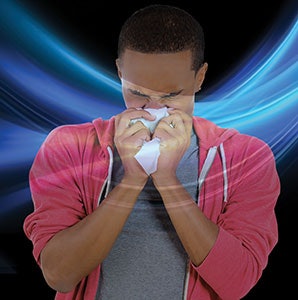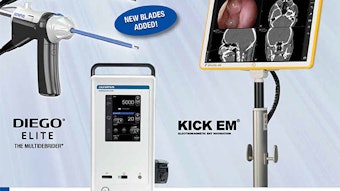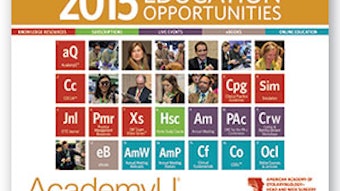CLINICAL PRACTICE GUIDELINEAllergic rhinitis
Adapted from the February 2015 Supplement to Otolaryngology–Head and Neck Surgery. Read the guideline at otojournal.org.
Adapted from the February 2015 Supplement to Otolaryngology–Head and Neck Surgery. Read the guideline at otojournal.org.

“The guideline makes clear and specific recommendations on what should be and should not be the first line of medication for allergic rhinitis,” explained Sandra Y. Lin, MD, one of the guideline’s authors. “That will be of great interest to clinicians, as well as the recommendation on immunotherapy as it expands the indicators to include patients who want therapy to modify their immune systems’ responses to allergens.”
What might surprise readers about the guideline’s 14 recommendations? “Acupuncture,” Lin said. “Some may not expect the recommendation regarding acupuncture as I think U.S. physicians may be less familiar with the literature that supports its use.”
The guideline’s 14 recommendations were developed to optimize patient care and address quality improvement opportunities for all clinicians, in any setting, who are managing patients with AR. The full guideline, as well as other resources, is available at www.entnet.org/AllergicRhinitisCPG.
Guideline recommendations
Patient history and physical examination
Clinicians should make the clinical diagnosis of allergic rhinitis when patients present with a history and physical exam consistent with an allergic cause and one or more of the following symptoms: nasal congestion, runny nose, itchy nose, or sneezing. Findings of AR consistent with an allergic cause include, but are not limited to, clear rhinorrhea, nasal congestion, pale discoloration of the nasal mucosa, and red and watery eyes.
Allergy testing
Clinicians should perform and interpret, or refer to a clinician who can perform and interpret, specific IgE (skin or blood) allergy testing for patients with a clinical diagnosis of allergic rhinitis who do not respond to empiric treatment, or when the diagnosis is uncertain, or when knowledge of the specific causative allergen is needed to target therapy.
Imaging
Clinicians should not routinely perform sinonasal imaging in patients presenting with symptoms consistent with a diagnosis of allergic rhinitis.
Environmental factors
Clinicians may advise avoidance of known allergens or may advise environmental controls (i.e. removal of pets, the use of air filtration systems, bed covers, and acaricides [chemical agents that kill dust mites]) in allergic rhinitis patients who have identified allergens that correlate with clinical symptoms.
Chronic conditions and comorbidities
Clinicians should assess patients with a clinical diagnosis of allergic rhinitis for, and document in the medical record, the presence of associated conditions such as asthma, atopic dermatitis, sleep disordered breathing, conjunctivitis, rhinosinusitis and otitis media.
Topical steroids
Clinicians should recommend intranasal steroids for patients with a clinical diagnosis of allergic rhinitis whose symptoms affect their quality of life (QOL).
Oral antihistamines
Clinicians should recommend oral second generation/less sedating antihistamines for patients with allergic rhinitis and primary complaints of sneezing and itching.
Intranasal antihistamines
Clinicians may offer intranasal antihistamines for patients with seasonal, perennial, or episodic allergic rhinitis.
Oral Leukotriene Receptor Antagonists (LTRAs)
Clinicians should not offer oral leukotriene receptor antagonists as primary therapy for patients with allergic rhinitis.
Combination therapy
Clinicians may offer combination pharmacologic therapy in patients with allergic rhinitis who have inadequate response to pharmacologic monotherapy.
Immunotherapy
Clinicians should offer or refer to a clinician who can offer immunotherapy (sublingual or subcutaneous) for patients with allergic rhinitis who have inadequate response to symptoms with pharmacologic therapy with or without environmental controls.
Inferior turbinate reduction
Clinicians may offer, or refer to a surgeon who can offer, inferior turbinate reduction in patients with allergic rhinitis with nasal airway obstruction and enlarged inferior turbinates who have failed medical management.
Acupuncture
Clinicians may offer acupuncture, or refer to a clinician who can offer acupuncture, for patients with allergic rhinitis who are interested in non-pharmacologic therapy.
Herbal therapy
No recommendation regarding the use of herbal therapy for patients with allergic rhinitis.
Guideline authors
Michael D. Seidman, MD; Richard K. Gurgel, MD; Sandra Y. Lin, MD; Seth R. Schwartz, MD, MPH; Fuad M. Baroody, MD; James R. Bonner, MD; Douglas E. Dawson, MD; Mark S. Dykewicz, MD; Jesse M. Hackell, MD; Joseph K. Han, MD; Stacey L. Ishman, MD, MPH; Helene J. Krouse, PhD, ANP-BC, CORLN; Sonya Malekzadeh, MD; James (Whit) W. Mims, MD; Folashade S. Omole, MD; William D. Reddy, L.Ac., Dipl.Ac.; Dana V. Wallace, MD; Sandra A. Walsh, BS (MdT); Barbara E. Warren, PsyD, MEd; Meghan N. Wilson, MD, and Lorraine C. Nnacheta, MPH
Disclaimer
The clinical practice guideline is not intended as the sole source of guidance in managing patients with allergic rhinitis (AR). Rather, it is designed to assist clinicians by providing an evidence-based framework for decision-making strategies. The guideline is not intended to replace clinical judgment or establish a protocol for all individuals with this condition and may not provide the only appropriate approach to diagnosing and managing this program of care. As medical knowledge expands and technology advances, clinical indicators and guidelines are promoted as conditional and provisional proposals of what is recommended under specific conditions but are not absolute. Guidelines are not mandates; these do not and should not purport to be a legal standard of care. The responsible physician, in light of all circumstances presented by the individual patient, must determine the appropriate treatment. Adherence to these guidelines will not ensure successful patient outcomes in every situation. The AAO-HNSF emphasizes that these clinical guidelines should not be deemed to include all proper treatment decisions or methods of care, or to exclude other treatment decisions or methods of care reasonably directed to obtaining the same results.















